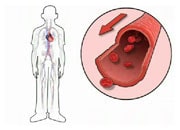Cardiac Resynchronisation Therapy (CRT)
What does it do?

CRT not only functions as a pacemaker but it re-coordinates (resynchronises) the beating of the two ventricles by pacing both simultaneously and specifically improving contraction of the left ventricle. This improves the overall efficiency of your heart. CRT therefore differs from typical pacemakers, which only pace the right ventricle and control heart rate. CRT devices may not only improve the symptoms of heart failure but have been shown to prolong long-term survival. Doctors frequently choose to combine a CRT with an ICD in the same device. In this case, the device is termed a CRT-D.
Where does it go and how is it put in place?
Like standard pacemakers, the CRT device is the size of a pocket watch. A CRT device is usually implanted with a local anaesthetic, just under your collarbone with flexible leads (coated wires) coming from it that are positioned in your heart. The procedure usually takes 1-2 hours.
The electrode lead is inserted into a vein at the shoulder or the base of the neck. The cardiologist guides the lead into the correct chamber of the heart, checking its position on an X-ray screen, and secures it in position with a stitch at your shoulder. The lead is then connected to the pacemaker and the pacemaker is fitted into a small ‘pocket’, or space, between the skin and the chest muscle. The amount of electrical energy needed to stimulate the heart to contract is then tested and the pacemaker is adjusted.
After the procedure
After your device has been fitted, you may feel some pain or discomfort and there may be some bruising at the site of the device but these problems usually disappear in a few days. Most people are walking around later the same day and resume normal activities again within 2-4 weeks.
The functioning and battery life of your device must be checked regularly at a cardiac clinic. Depending on the device implanted, a telemonitoring follow up may be proposed to monitor your device, allowing rapid identification of heart rhythm disturbance and technical dysfunction and may improve your care and reduce the need for device clinic visits.
If the battery must be replaced, only the device needs to be replaced (not the leads). The battery usually lasts between 5 and 7 years before it needs to be replaced.
It is important that you let any doctors or dentists know that you have a CRT device before going for any procedures. Although most medical and dental procedures are unlikely to interfere with the functioning of your device, some may require precautionary measures that minimise any interference.
CRT devices may sometimes be detected by airport security machines, but the functioning of the device is rarely affected, so if you have a CRT device you should always inform the security personnel.
Two types of CRT devices are used:
- CRT-P (CRT with pacemaker function)
- CRT-D (CRT with pacemaker and ICD function)




















